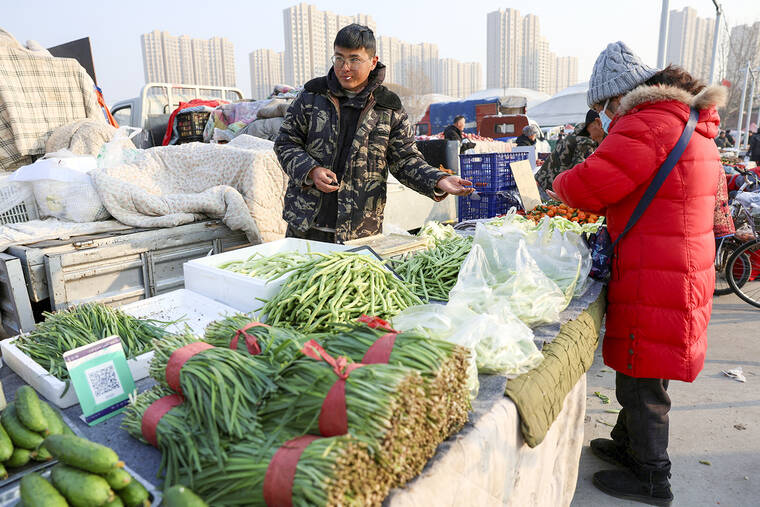China reveals $1.4 trillion plan to bail out local governments
TAIPEI, Taiwan — The Chinese government on Friday approved a $1.4 trillion plan to revive the economy, authorizing local governments to refinance crushing debts that have left some cities unable to pay their bills.
The move caps a series of steps that China’s leaders started rolling out in September to stimulate growth. The effort took on greater urgency this week with the election of Donald Trump as president of the United States.
ADVERTISING
Trump has promised to put additional tariffs as high as 60% on Chinese goods imported by the United States, a policy shift that could draw sharp retaliation by China and escalate already tense relations between the world’s two largest economies.
China’s economy has struggled to regain momentum this year. The grinding collapse of the real estate market, where most Chinese households build their wealth, has depressed prices and left consumers reluctant to spend. Home prices have fallen about 10% a year for the past three years, and foreclosures are soaring.
At the same time, local governments have piled up unsustainable levels of debt. For years, they drove growth by borrowing enormous sums to pay for infrastructure projects. Then they took on even more of debt during the COVID-19 pandemic. China’s central government has relatively low levels of public debt because much of spending is largely funneled through cities and provinces.
Despite the mounting economic problems, China’s top leaders had held back from taking significant steps to break the cycle. Beijing has historically favored state-led growth rather than direct consumer stimulus. In late September, however, the government took action and made it easier for households and companies to borrow.
The plan announced Friday by the Standing Committee of the National People’s Congress will allow additional government borrowing of about $838 billion over three years and another $539 billion over five years. Local governments will be able to free up cash by refinancing their highest-interest debts. Some analysts had expected a more robust package of fiscal relief for banks and the housing sector.
The debt swap, although substantial, will alleviate only a fraction of the debt attributed to China’s local governments, economists said.
A large portion of that debt is held in special financial vehicles that keep it off official public budgets. The International Monetary Fund estimated last year that such hidden debt added up to $8.3 trillion.
The debt level of most provincial governments doubled from 2018 to 2023, said Victor Shih, a specialist in Chinese politics and finance at the University of California, San Diego.
Over the past few years, some indebted local governments have fallen behind on paying the wages of city and county level employees. Getting these workers their salaries would help get middle-class people spending again, Shih said.
But the measures announced Friday, which officials said would save local governments about $84 billion over five years, are a comparatively small sum, Shih said. “It’s an accounting exercise,” he said. “It does nothing for the real economy.”
The last time the Chinese government stepped in to relieve the debt burden of local governments was in 2015, when it allowed refinancing of about $1.6 trillion over three years.
The current steps do not address the underlying problem, said Wang Tao, chief China economist at UBS, a Swiss bank.
“It does help to significantly reduce the debt service payment issue in the next few years, but does not solve the local government debt issue,” Wang said.
In September, China’s central bank cut short-term interest rates and rates on existing mortgages, reduced minimum down payments for housing purchases and freed the country’s state-controlled commercial banks to lend more, including to promote stock purchases.
Dozens of Chinese cities have relaxed restrictions on homebuying in recent months in a bid to get more people to buy.
One of the most tangible effects so far of the stimulus push has been a rally in China’s stock markets, which had been among the worst performing in the world before the recent turnabout. Since the central bank’s first moves on Sept. 24, the CSI 300, an index of big companies that trade in Shanghai and Shenzhen, has jumped more than 20%.
But the initial market reaction to the latest stimulus measures suggested some disappointment among investors, with stocks in Hong Kong falling in after-hours trading.
The government’s actions in recent weeks will help the economy hit the growth target of around 5%, but will not reinvigorate demand in the housing market, said Larry Hu, chief China economist for Macquarie Group, an Australian financial services firm. “For that purpose, we need a more sizable stimulus,” he said.
More funding could be announced after the Central Economic Work Conference, an annual meeting expected to be held next month to set economic policy. But more money will not address the fundamental restructuring that some economists say is what the economy really needs.
“Even though this is a large amount of money, it is still basically kicking the can down the road,” Shih said.
This article originally appeared in The New York Times.
© 2024 The New York Times Company





